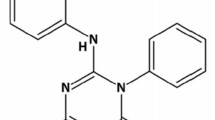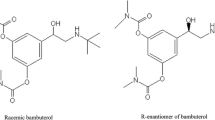Abstract
The enantiomers of hexobarbital, designated asS(+)-HB andR(−)-HB, were administered intra-arterially to rats in a dose of 25 mg· kg−1. Blood pharmacokinetics of the parent compound and two metabolites as well as urinary excretion of three major metabolites were studied. Using previously obtained data following oral administration ofS(+)-HB andR(−)-HB two different methods for calculation of the hepatic extraction ratio (E) were compared. The metabolite profile in the urine after intra-arterial administration was not basically different from corresponding data on oral administration. The clearance of low-dose, intra-arterially administeredS(+)-HB is useful as an indicator of hepatic blood flow in the rat.
Similar content being viewed by others
References
Van der Graaff M, Vermeulen NPE, Joeres RP, Vlietstra T, Breimer DD. Correlations in the metabolism of hexobarbital and antipyrine in rats. J Pharmacol Exp Ther 1983;227:459–65.
Van der Graaff M, Vermeulen NPE, Joeres RP, Breimer DD. Disposition of hexobarbital enantiomers in the rat. Drug Metab Dispos 1983;11:489–93.
Van der Graaff M, Vermeulen NPE, Langendijk PNJ, Breimer DD. Pharmacokinetics of simultaneously administered hexobarbital and heptabarbital in rats: an alternative approach to metabolic correlation studies. J Pharmacol Exp Ther 1983;225:747–51.
Wilkinson GR, Shand DG. A physiological approach to hepatic drug clearance. Clin Pharmacol Ther 1975; 18:377–89.
Liehr H, Grün M, Thiel H, Krauss R, Rost R. Hepatic blood flow in rats with galactosamine hepatitis. Acta Hepato Gastroenterol 1972;19:259–63.
Ohnhaus EE, Locher JTh. Liver blood flow and volume following chronic phenobarbitone administration. Eur J Pharmacol 1975;31:161–5.
Denis P, Ossenberg FW, Benhamou J-P. Hepatic blood flow and enzyme induction in the rat. Biochem Pharmacol 1975;24:249–51.
Gillette JR, Saul WF, Malirig HM. A new principle for estimating hepatic blood flow rates. Pharmacology 1981;23:237–46.
Rowland M, Benet LZ, Graham GE. Clearance concepts in pharmacokinetics. J Pharmacokinet Biopharm 1977;1:123–7.
Pang KS, Rowland M. Hepatic clearance of drugs, III. Additional experimental evidence supporting the wellstirred model, using metabolite (MEGX) generated from lidocaine under varying hepatic blood flow rates and linear conditions in the perfused rat liverin situ preparation. J Pharmacokinet Biopharm 1977;5:681–99.
Pantuck EJ, Hsiao K-C, Loub WD, Wattenberg LW, Kuntzman R, Conney AH. Stimulatory effect of vegetables on intestinal drug metabolism in the rat. J Pharmacol Exp Ther. 1976;198:278–83.
Lister JL, Virgo BB. Aniline and hexobarbital hydroxylases from rat lung and kidney: neither sex dependent nor inducible with phenobarbital. Can J Physiol Pharmacol 1982;60: 1247–50.
Marietta MP, Vesell ES, Hartman RD, Weisz J, Dvorchick B. Characterization of cytochrome P-450 dependent aminopyrineN-demethylase in rat brain: comparison with hepatic aminopyrineN-demethylation. J Pharmacol Exp Ther 1979;208:271–9.
Rane A, Wilkinson GR, Shand DG. Predictions of hepatic extraction ratio fromin vitro measurement of intrinsic clearance. J Pharmacol Exp Ther 1977, 200: 420–4.
Kupfer D, Rosenfeld J. A sensitive radioactive assay for hexobarbital hydroxylase in hepatic microsomes. Drug Metab Dispos 1973;1:760–5.
Heinemeyer G, Nigam S, Hildebrandt AG. Hexobarbital-binding, hydroxylation and hexobarbital-dependent hydrogen peroxide production in hepatic microsomes of guinea pig, rat and rabbit. Naunyn-Schmiedebergs Arch Pharmacol 1980;314:201–10.
Dvorchick BH, Hartman RD. Hydroxylation of hexobarbital and benzo(a)pyrene by hepatic microsomes isolated from the fetal stumptailed monkey (Macaca arctoides). A development study. Biochem Pharmacol 1982;31:1150–3.
Igari Y, Sugiyama Y, Awaza S, Hanamo M. Comparative physiologically based pharmacokinetics of hexobarbital, phénobarbital and thiopental in the rat. J Pharmacokinet Biopharm 1982;10:53–75.
Van den Berg AP. Cytochrome P-450 substrate interaction and hepatic drug metabolism in the mouse. Rotterdam: Erasmus Universiteit Rotterdam, 1977. Dissertation.
Miyano K, Fujii Y, Toki S. Stereoselective hydroxylation of hexobarbital enantiomers by rat liver microsomes. Drug Metab Dispos 1980;8:104–10.
Drew R, Priestly BG, O'Reilly WJ. Hexobarbital pharmacokinetics after ligation of the common bile duct. J Pharmacol Exp Ther 1977;201:534–40.
Vermeulen NPE, Danhof M, Setiawan I (Thio TH), Breimer DD. Disposition of hexobarbital in the rat: estimation of ‘first-pass’ elimination and influence of ether anaesthesia. J Pharmacol Exp Ther 1983;226: 201–5.
Griffeth LK, Rosen GM, Rauckman EJ. Effects of model traumatic injury on hepatic drug metabolism in the rat. II.In vivo metabolism of hexobarbital and zoxazolamine. Drug Metab Dispos 1984;12:582–7.
Rowland M, Tozer TN. Clinical pharmacokinetics: concepts and applications. Philadelphia: Lea & Febiger, 1980.
Roth RA, Rubin RJ. Role of blood flow in carbon monoxide and hypoxic hypoxia-induced alterations in hexobarbital metabolism in rats. Drug Metab Dispos 1976;4:460–7.
Richter E, Heusler H, Epping J, et al. Glucuronide conjugation as an alternative biotransformation pathway of hexobarbital and methohexital in rats with experimental hepatitis and cholestasis [Abstract]. 17th Meeting of the European Association for the Study of the Liver. Göteborg, Sweden, September 9–11, 1982.
Miyano K, Ota T, Toki S. Stereoselective formation of glucuronides in metabolism of hexobarbital enantiomersin vivo. Drug Metab Dispos 1981;9:60–4.
Author information
Authors and Affiliations
Rights and permissions
About this article
Cite this article
Van der Graaff, M., Vermeulen, N.P.E. & Breimer, D.D. Intra-arterial administration of hexobarbital enantiomers to the rat: disposition and estimation of apparent extraction ratio. Pharmaceutisch Weekblad Scientific Edition 8, 139–144 (1986). https://doi.org/10.1007/BF02086148
Received:
Accepted:
Issue Date:
DOI: https://doi.org/10.1007/BF02086148




